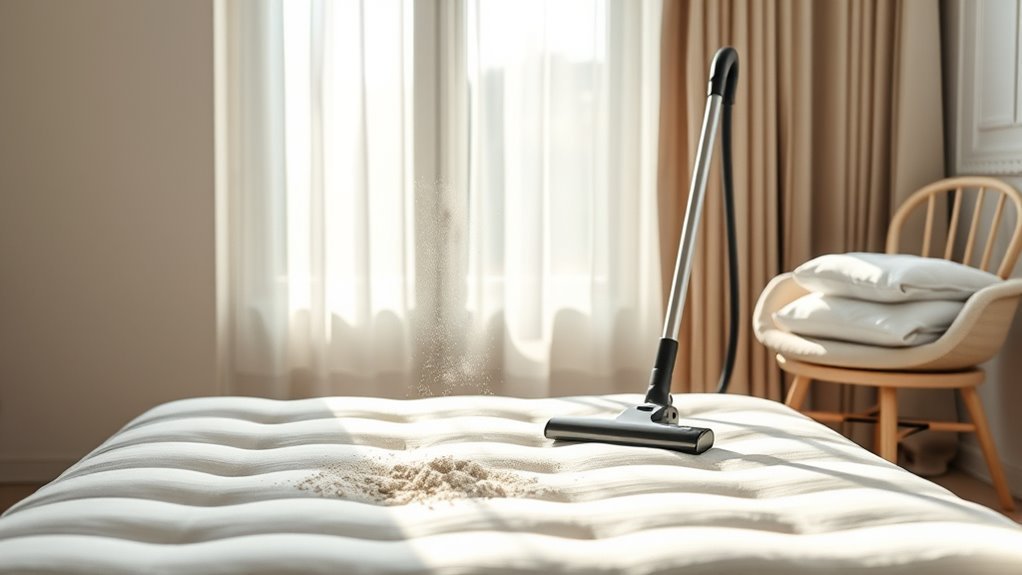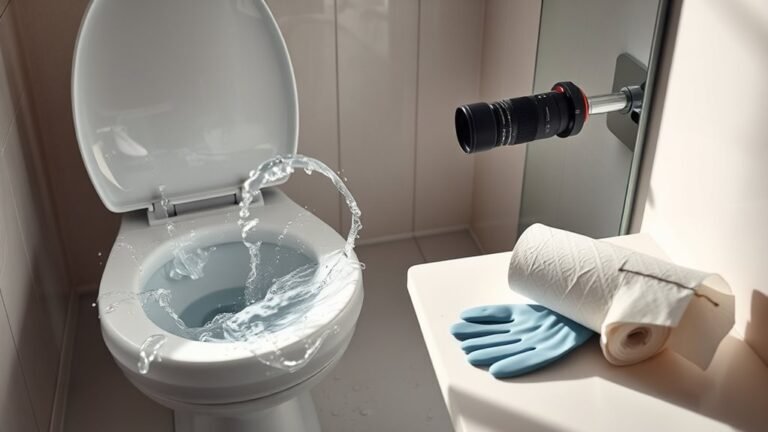Best Way to Sanitize Your Mattress
To sanitize your mattress effectively, start by removing all bedding and vacuuming the entire surface, including crevices, to eliminate dust and allergens. Next, apply natural cleaners like vinegar to disinfect and baking soda to absorb moisture and odors—let it sit several hours before vacuuming again. For deeper sanitization, use a handheld steam cleaner to kill bacteria and dust mites without chemicals. Keep up regular cleaning habits to maintain freshness and hygiene. You’ll find additional tips to optimize mattress care ahead.
Why Sanitizing Your Mattress Is Important

Although you might not see it, your mattress can harbor dust mites, bacteria, and allergens that affect your health. These unseen contaminants compromise mattress health and directly impact your sleep quality by triggering allergies and respiratory issues. Regular sanitization eliminates these harmful agents, reducing the risk of skin irritations and improving overall hygiene. By maintaining a clean mattress, you create a healthier sleep environment, promoting deeper, uninterrupted rest essential for your well-being and daily performance. Ignoring this upkeep can lead to deteriorated mattress conditions and diminished sleep quality, which affects your freedom to live fully energized. Prioritizing mattress sanitization is a practical step toward safeguarding your health, ensuring your mattress supports restorative sleep and contributes positively to your lifestyle.
Preparing Your Mattress for Sanitization
Before you start sanitizing, make certain to remove all bedding completely to access the mattress surface. Next, vacuum the mattress thoroughly to eliminate dust, dirt, and debris. This preparation guarantees the sanitizing process will be more effective and reach deeper layers.
Remove Bedding Completely
Start by removing all bedding from your mattress, including sheets, pillowcases, blankets, and mattress protectors. This step is essential for effective mattress care, ensuring no barrier prevents thorough cleaning. Removing all layers exposes the mattress surface, allowing you to address dirt, allergens, and potential contaminants directly. It also promotes bedding hygiene by preventing cross-contamination between your washing items and the mattress itself. Be methodical—check corners and seams for hidden fabrics or small items. Once removed, launder your bedding according to care instructions, ideally using hot water to eliminate bacteria and dust mites. By fully removing bedding, you create the freedom to sanitize your mattress properly, setting the foundation for a healthier sleep environment and extending your mattress’s lifespan.
Vacuum Thoroughly First
Once you’ve removed all bedding, you’ll want to vacuum your mattress thoroughly to eliminate dust, dirt, and allergens embedded in its surface. Mattress vacuuming is crucial to reduce dust mites, which thrive in fabric and can trigger allergies. Use a vacuum with strong suction and a HEPA filter for best results. Move slowly across the mattress, covering every inch.
| Step | Purpose |
|---|---|
| Use HEPA filter | Captures microscopic allergens |
| Vacuum edges | Removes accumulated debris |
| Focus seams | Dislodges dust mites |
| Repeat on both sides | Guarantees thorough cleaning |
This method clears the mattress efficiently, giving you freedom from allergens before deeper sanitization.
Using Vacuuming to Remove Surface Dust and Allergens

Vacuuming your mattress thoroughly at least once a month helps eliminate surface dust, dead skin cells, and common allergens that accumulate over time. Start by attaching the appropriate vacuum attachments, like the upholstery tool, which is designed to reach tight seams and crevices where dust hides. Move the vacuum slowly across the mattress surface to guarantee effective dust removal without disturbing the mattress fibers. Don’t forget to vacuum the sides and edges, as allergens tend to gather there as well. Regular vacuuming reduces the buildup of irritants and improves your sleep environment. By maintaining this routine, you take control over your mattress hygiene, creating a fresher, healthier space without relying on harsh chemicals or complicated processes.
Applying Natural Cleaning Solutions for Deeper Cleaning
To achieve a deeper clean, you can apply natural solutions like vinegar and baking soda, which effectively break down stains and odors. Adding essential oils not only enhances the scent but also provides antimicrobial benefits. For tougher spots, hydrogen peroxide is a safe option that helps eliminate bacteria without damaging your mattress.
Vinegar and Baking Soda
Two common household ingredients, vinegar and baking soda, offer an effective, natural way to sanitize your mattress deeply. Vinegar benefits include its ability to kill bacteria, neutralize odors, and break down grime without harsh chemicals. To start, lightly spray white vinegar onto the mattress surface, avoiding oversaturation. Let it sit for about an hour to allow the vinegar to work. Next, evenly sprinkle baking soda over the dampened areas; baking soda absorbs moisture and odors, enhancing freshness. Leave the baking soda on for several hours or overnight for thorough drying and deodorizing. Finally, vacuum the mattress carefully to remove all baking soda residue. This method harnesses natural cleaning power, giving you a sanitized mattress while maintaining your freedom from synthetic cleaners.
Essential Oils Benefits
Although vinegar and baking soda effectively sanitize your mattress, incorporating essential oils can enhance the cleaning process by adding antimicrobial properties and pleasant natural scents. When you mix a few drops of essential oils like tea tree, lavender, or eucalyptus with water, you not only boost disinfection but also enjoy aromatherapy benefits that promote relaxation and better sleep. Apply this solution lightly to your mattress with a spray bottle, then allow it to air dry thoroughly. This method deepens cleaning without harsh chemicals, giving you a fresh, sanitized sleeping surface. By using essential oils, you take control of your environment, combining natural cleaning power with wellness advantages, ensuring your mattress is clean and inviting every night.
Hydrogen Peroxide Usage
One effective natural cleaner you can use for deeper mattress sanitization is hydrogen peroxide. This cleaning solution is known for its powerful antibacterial and antifungal properties, making it ideal for eliminating hidden germs and stains. To apply, mix a 3% hydrogen peroxide solution with water in a spray bottle, typically a 1:1 ratio works well. Lightly mist the mattress surface, focusing on stains or areas prone to moisture. Avoid soaking the mattress to prevent damage. Allow it to air dry completely, as this guarantees the hydrogen peroxide has time to disinfect thoroughly. Using hydrogen peroxide as a cleaning solution offers a chemical-free alternative that promotes a healthier sleeping environment, giving you the freedom to maintain your mattress with confidence and simplicity.
Utilizing Steam Cleaning for Effective Sanitization
When you want to eliminate allergens, dust mites, and bacteria from your mattress without using harsh chemicals, steam cleaning offers an effective solution. One of the key steam cleaning benefits is its ability to sanitize deeply by using high-temperature vapor, which kills microbes on contact and penetrates fabric fibers. To get started, use a handheld steam cleaner with a fabric attachment, moving it slowly across the mattress surface to guarantee even coverage. Avoid saturating the mattress by controlling the steam output, allowing it to dry thoroughly afterward to prevent mold growth. This method preserves mattress integrity while providing a chemical-free clean. By mastering these steam cleaning techniques, you’ll enjoy a fresher, healthier sleeping environment that supports your freedom to breathe easy every night.
How to Use Baking Soda to Eliminate Odors and Moisture

Since mattresses can trap odors and moisture over time, using baking soda is an effective way to neutralize smells and absorb dampness. Sprinkle a generous layer of baking soda evenly across your mattress surface. The baking soda benefits include its natural ability to lift odors by neutralizing acidic and basic compounds, providing thorough odor removal. Let the baking soda sit for at least several hours, preferably a full day, to maximize moisture absorption and odor control. Afterward, vacuum the mattress carefully to remove all the baking soda residue. This method not only refreshes your mattress but also helps maintain a healthier sleeping environment by reducing allergens linked to dampness. By incorporating baking soda into your mattress care routine, you gain a simple, chemical-free solution that supports your freedom from unpleasant smells and moisture buildup.
Tips for Maintaining a Clean and Sanitized Mattress Regularly
Although deep cleaning is essential, maintaining a clean and sanitized mattress requires consistent care. You should establish a regular mattress care routine to extend its freshness and hygiene. Start by vacuuming your mattress weekly to remove dust, allergens, and debris. Rotate or flip your mattress every three months to distribute wear evenly. Use a mattress protector to shield against spills and stains, reducing the need for intensive cleaning. Pay attention to your cleaning frequency; aim for deep cleaning, including deodorizing with baking soda, every six months. Address spills or stains immediately with gentle cleaners to prevent lasting damage. By following these methodical steps, you’ll guarantee your mattress remains sanitary and comfortable, granting you freedom from allergens and discomfort. Staying consistent is key to effective mattress care.
Frequently Asked Questions
Can Mattress Sanitizing Prevent Bed Bug Infestations?
You might wonder if mattress sanitizing can prevent bed bug infestations. While sanitizing helps eliminate dust mites and bacteria, it’s not a guaranteed method for bed bug prevention. To protect yourself fully, focus on thorough mattress maintenance—regular vacuuming, using protective covers, and inspecting for signs of bed bugs. Combining these steps gives you more freedom from infestations and keeps your sleeping space healthier over time.
How Often Should I Sanitize a Mattress in a Humid Climate?
In a humid climate, your mattress cleaning frequency should be increased to prevent mold and mildew growth. Ideally, sanitize your mattress every 3 to 4 months, as humidity effects can promote moisture retention and allergens. Regularly airing out your mattress and using a dehumidifier helps maintain dryness. Staying consistent with this routine guarantees your mattress stays fresh and hygienic, giving you the freedom to enjoy a healthier sleeping environment.
Are Sanitizing Sprays Safe for People With Asthma?
Sprays sparking sneezes and symptoms should be scrutinized carefully. If you have asthma, you’ll want to select sanitizing sprays with safe ingredients free from harsh chemicals, fragrances, or irritants that can trigger asthma symptoms. Look for labels highlighting hypoallergenic and non-toxic formulas, and always test in a small area first. Proper ventilation and avoiding direct inhalation during application will help you stay symptom-free while sanitizing safely.
Can I Sanitize a Mattress With Pets in the House?
Yes, you can sanitize a mattress even with pets in the house, but you should take precautions. Start by removing pet hair and addressing pet odors with a vacuum and pet-safe cleaning products. Use mattress cleaning methods that neutralize bacteria without harsh chemicals, ensuring your pets aren’t exposed. Keep pets out of the room during cleaning and until the mattress is fully dry. This approach maintains hygiene while respecting your furry friends’ freedom.
Does Sanitizing Affect the Mattress Warranty?
Remember, “an ounce of prevention is worth a pound of cure.” When you sanitize your mattress, check mattress warranty policies carefully—some methods, like harsh chemicals or excessive moisture, can void warranties. Comparing sanitizing methods helps; gentle approaches such as vacuuming or steam cleaning often maintain warranty validity. To keep your freedom in choosing cleaning methods, always follow manufacturer guidelines, ensuring effective sanitizing without risking your mattress protection.






